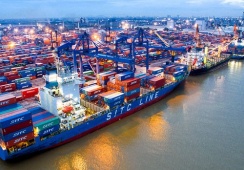
Vietnam's economic landscape in the first eight months of 2024 is full of positive indicators. Remarkably, the country's imports and exports have soared, exceeding US$511 billion, an increase of 16.7% compared to the same period in 2023.
This impressive performance has been driven by a rebound in export orders for key sectors such as textiles and footwear, as well as a steady inflow of foreign investment and a remarkable recovery in manufacturing and processing. In addition, agricultural exports are flourishing, benefiting from both bumper harvests and attractive prices.
These figures suggest that the Ministry of Industry and Trade's target of 6% growth in export turnover, set at the beginning of the year, is achievable. To shed light on these changes, local economist Nguyen Minh Phong shared with Industry and Trade Newspaper his observations.
| Economist Nguyen Minh Phong. Photo: Thu Huong/The Hanoi Times |
What are comment on Vietnam's economic performance over the past eight months, particularly in terms of industrial production and import/export trends?
Vietnam's economic performance in the first eight months of 2024 is positive, contributed by the efforts made from 2023 onwards, combined with the resulted made in 2024 and the opportunities that are currently being seized.
The situation fuels stronger growth in 2025.
Overall, Vietnam will remain one of the world's leading countries in terms of economic growth throughout 2024. The economy is benefiting from several drivers.
A key driver is the recovery in orders, particularly in the textile and footwear industries.
Moreover, Vietnam is becoming an attractive destination for foreign direct investment (FDI) flows, with significant investment flowing into promising sectors such as high technology, chip manufacturing, and technology services.
Meanwhile, tourism is currently booming while the agricultural sector is thriving, with a bumper harvest, especially in rice production.
However, the economy still faces several challenges in 2024, such as the ability to access and absorb capital, as well as issues related to the disbursement of public investment.
Despite the challenges, the World Bank has confidently raised its growth forecast for Vietnam's economy to an impressive 7% by 2024 which could be higher.
In addition, several international organizations predict that if Vietnam realizes its potential, economic growth could rise to 8% or even 9%. This momentum could propel the country's growth trajectory well into 2029, promising an exciting future.
What are Vietnam's priorities to achieve 6.5% growth target set at the beginning of the year?
In my view, the government has already identified most of the key solutions, tasks and drivers, and has incorporated them in various resolutions.
In the coming months, it's essential to implement measures such as pursuing the collection of state budget revenues, prudently managing state expenditures, tightening discipline to improve budget efficiency, and accelerating digital transformation initiatives.
We also need to move away from the mindset of hesitation and fear of responsibility.
We should also seize the opportunities offered by the new generation of free trade agreements (FTAs) and attract more foreign investment.
Finally, ongoing efforts to improve the investment climate and streamline administrative procedures will be key to our success.
In 2024, the Ministry of Industry and Trade aims to increase export turnover by over 6% compared to 2023. What should the sector do to reach the target?
| Catfish has been a highlight of Vietnam's exports. Photo: Giang Lam |
Alongside the Ministry of Finance and the Ministry of Planning and Investment, the Ministry of Industry and Trade stands out as a key driver of the economy. It has been proactive in tackling challenges, from managing import-export operations to resolving electricity issues, improving infrastructure, overseeing environmental regulations and ensuring market stability.
In the first eight months alone, total import and export turnover is projected to reach an impressive US$511 billion, up 16.7% on year while trade surplus hit $19 billion during the period.
With such strong results, I am confident that the Ministry of Industry and Trade will achieve its goals in 2024 and drive Vietnam's imports and exports to new heights, providing vital impetus for the entire economy.
What are your predictions for Vietnam's economy in 2025?
As 2025 is particularly important to achieve the 2021-2025 targets. The economy is likely to encounter many promising opportunities, both domestically and internationally.
On the international front, the global situation is gradually stabilizing, countries are adjusting to geopolitical conflicts and challenges related to raw materials and markets are improving.
Moreover, Vietnam is strengthening its international standing, enhancing global relationships, and improving the investment and business environment. These factors present positive opportunities for Vietnam's economic growth in 2025.
In the next year, Vietnam will finalize personnel preparations for the 14th Congress. This will serve as a significant boost for both the government and the economy.
However, 2025 will also bring unexpected challenges, such as climate change and non-traditional security issues. Learning from the Covid-19 experience, the government, ministries and the business community have developed dynamic growth scenarios, categorized into best, moderate and worst case outcomes.
In this respect, forecasts outside the official scenarios for 2025 are needed. An effective way to synchronize efforts with national economic management and development plans is to implement a "red, yellow, green" forecasting system.
Moreover, accelerating digital transformation is essential for building a digital economy and creating a fully digital society. This transformation will enable us to adapt to global economic changes and seize the opportunities of the Fourth Industrial Revolution.
These proactive preparations will not only energize Vietnam's economy in 2025, but also enable it to break out of the middle-income trap and position itself as a rising Asian tiger, as many international organizations predict.
Thank you for your time!




